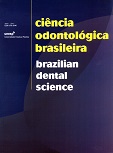Avaliação bioquímica de xenoimplantes em subcutâneo de rato
DOI:
https://doi.org/10.14295/bds.2006.v9i4.455Abstract
O objetivo deste trabalho foi avaliar o potencial das fosfatases ácidas como biomarcadores da resposta tecidual ao implante de osso medular inorgânico bovino. Cápsulas de colágeno foram utilizadas como carreadores de partículas macro (1000 a 2000 μm) e microgranulares (200 a 600 μm) e implantados em subcutâneo de 60 ratos Wistar, divididos aleatoriamente em 3 grupos: Grupo I (cápsula de colágeno vazia), Grupo II (macrogranular) e Grupo III (microgranular). Decorridos 10, 20, 30 e 60 dias pós-cirúrgico, os animais foram mortos para a remoção do tecido reacional de onde se obteve o extrato. As atividades específi cas (AE) das fosfatases ácidas total (FAT), lisossomal (FAL) e a de baixo peso (FABMr) foram realizadas no pH 5,0 utilizando o p-nitrofenilfosfato como substrato, na presença de inibidores específi cos para cada enzima; a atividade tirosina (Tyr-P) fosfatase foi obtida nas mesmas condições utilizando a tirosina fosfato como substrato. No Grupo I observou-se que a atividade da FAT e FAL não variaram signifi cativamente ao longo dos períodos experimentais, entretanto ambas as enzimas apresentaram atividades signifi cativamente maior (p<0,05) no grupo II que no grupo III na maioria dos períodos avaliados. A FABMr no grupo I foi menor (p<0,001) que nos grupos II (aos 10 e 30 dias) e III (aos 10 dias), mas nos períodos de 20 e 60 dias a FABMr foi maior (p<0,001). A Tyr-P detectada nos períodos de 20 e 60 dias era cerca de 18 vezes maior que aos 10 e 30 dias. Concluiu-se que a atividade da fosfatase ácida total, e suas isoformas FAL, FABMr e Tyr-P é signifi cativamente modulada durante a resposta tecidual ao implante de osso medular inorgânico bovino, tanto em função do período como do tamanho da partícula.
Downloads
Downloads
Published
How to Cite
Issue
Section
License
Brazilian Dental Science uses the Creative Commons (CC-BY 4.0) license, thus preserving the integrity of articles in an open access environment. The journal allows the author to retain publishing rights without restrictions.
=================




























